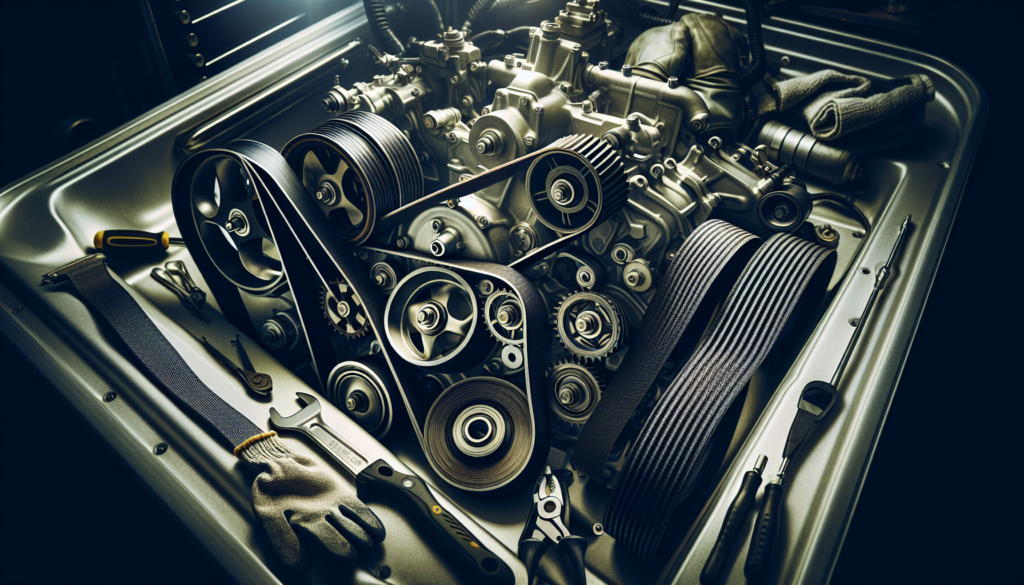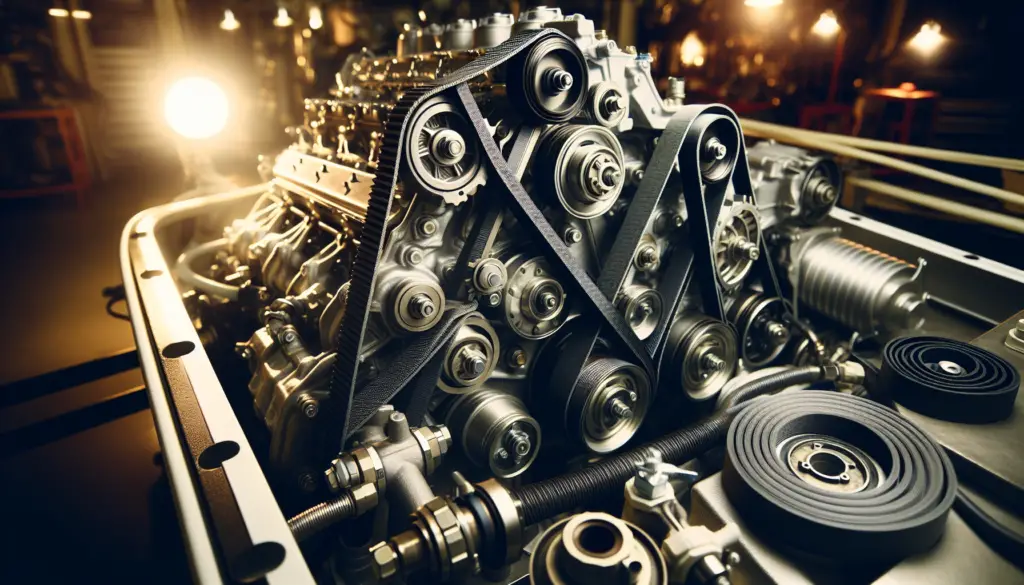Imagine you’re out in the open waters, reveling in the freedom of the sea, and suddenly your boat’s engine gives out. You soon find out it’s due to a faulty belt or hose, a small but vital part that was overlooked. Don’t let this scenario befall you. To ensure a smooth and worry-free sailing adventure, learning about the best practices for boat engine belt and hose replacement is key. The right knowledge can protect your boat engine’s health, ensure its longevity, and save you from avoidable complexities down the line. This comprehensive guide presents practical, easy-to-follow steps that can help you maintain your boat engine like a pro.

Understanding the Importance of Boat Engine Belts and Hoses
Understanding the function and importance of boat engine belts and hoses is fundamental in boat maintenance. These components may seem minor in the grand scheme of an entire boat setup, but they hold a significant role in your boat engine’s performance and overall health.
Role of Belts and Hoses in Boat Engine Functionality
Boat engine belts and hoses serve various essential roles. For one, the belts often drive the alternator, water pumps, and other integral engine parts. They transfer the power generated by the engine to these components. Hoses, on the other hand, serve as the delivery system for coolants, steering fluids, and fuels. They move these necessary fluids from one part of the engine to another.
Consequences of Neglecting Proper Maintenance
Neglecting the care of belts and hoses can lead to disastrous consequences. Broken belts can cause engine overheating, loss of steering, and even complete engine failure. Leaking hoses can also lead to dangerous situations, such as fire hazards from fuel leaks or a seized engine due to loss of coolant. Regular maintenance may seem tedious, but it’s definitely preferable compared to dealing with these potential complications.
Common Signs of Wear and Tear in Boat Engine Belts and Hoses
Common signs of wear and tear in belts and hoses include visible cracks, bulging, leaks, or loose belt tension. For hoses, a soft or mushy feel can also indicate deterioration. If you notice any of these signs, it’s a clear alert that your belts or hoses may need replacement soon.
Choosing the Right Replacement Belts and Hoses
Purchasing the right replacement parts is essential in maintaining the performance of your boat engine. Here are a few things to consider when choosing new belts and hoses.
Understanding Boat Engine Specifications
Firstly, it’s important to understand your boat engine specifications. Knowing details such as the correct size, type, and model of your belts and hoses can make the replacement process a lot smoother. Most of this information can be found on the parts themselves, in your boat manual, or from your boat manufacturer.
Selecting Quality Manufacturing Brands
Next, consider the quality of the manufacturing brands. Opt for trusted brands in the industry, ensuring the longevity and reliability of these parts. Remember, high-quality parts can withstand better in tough marine conditions and add years to your boat engine’s life.
Assessing Material Durability and Resistance
It’s also crucial to think about the belts and hoses material durability and resistance. Marine-grade materials that can withstand wear, heat, and chemical corrosion from sea water and engine fluids are highly recommended. These materials guarantee the robustness needed for a long service life.
Considerations for Your Boat’s Environmental Conditions
Lastly, your boat’s environmental conditions should also influence your choice. Factors such as climate, water salinity, and usage frequency can all affect the lifespan of your boat’s belts and hoses. So, choose ones that are designed for your specific boating environment.
Tools Needed for Belt and Hose Replacement
Proper tools can make replacing belts and hoses much easier. Consequently, it’s important to have the necessary equipment on hand.
Basic Hand Tools for Hose and Belt Replacement
Basic hand tools like wrenches, sockets, pliers, and screwdrivers are needed for loosening and tightening bolts and clamps. You’ll also need a flashlight for better visibility, especially when working in tight spaces.
Specialized Boat Engine Tools and their Uses
There are also specialized boat engine tools that can be very helpful. For example, a belt tension gauge helps ensure your belts are properly tightened. A hose cutter provides clean and precise cuts, preventing potential hose leakages.
Personal Protective Equipment and Safety Measures
Always prioritize your safety. Personal protective equipment such as gloves and safety glasses are essential. Remember, you’re working with potentially harmful fluids, and you want to protect yourself as much as possible.

Preparing for Belt and Hose Replacement
Preparing for belt and hose replacement goes a long way in ensuring a smooth operation. Here are a few things to keep in mind.
Mitigating Risk: Disconnecting Batteries and Securing Engine
Reduce the risk of electrical shocks by disconnecting the batteries first. Also, make sure the engine is off and properly secured to avoid accidental starts.
Identifying Belt and Hose Routing and Connections
This involves identifying how the belts and hoses are routed and connected. Take pictures or label the parts if needed, to help you during the re-installation process.
Organizing tools and Parts for easier access
Organize your tools and parts for easy access during the replacement process. This can significantly cut down on time and prevent the stress of searching for tools in the middle of a task.
Detailed Procedure for Belt Replacement
When replacing the belt, follow these steps to ensure a successful replacement.
Loosening and Removing Old Belt
Begin by loosening the tension on the old belt. Then, you can safely remove it from the pulley system. Be mindful not to force the belt off as it may cause damage to the pulleys.
Installing and Adjusting New Belt
Once the old belt is off, install the new one based on the routing you’ve identified earlier. Then, adjust the tension according to the manufacturer’s instructions.
Testing and Verifying Proper Belt Operation
Finally, start the engine and carefully observe the belt’s operation. If it’s running smoothly and quietly, then the installation was successful.
Detailed Procedure for Hose Replacement
Replacing hoses follows a similar procedure to belts.
Detaching and Removing Old Hose
Start by loosening the clips or clamps and carefully remove the old hose. Like with the belts, avoid forcing it off to prevent damage to the connectors.
Installing and Securing New Hose
Once you’ve removed the old hose, fit the new one onto the connectors, ensuring a tight fit. Secure it in place with new clamps or reuse the old ones if they are still in good condition.
Testing and Checking for Leaks or Issues
After installation, it’s essential to test your work. Start the engine and check for any leaks or issues. If everything is in order, then you’ve installed the hose correctly.
Post-Replacement Check-up
After any replacement, a thorough check-up is recommended.
Checking for Proper Tension in Newly Installed Belts
Belts should have the right tension to operate effectively. Over-tightened belts can strain the engine, while loose ones can lead to slippage.
Looking for Leaks or Loose Connections in New Hoses
Similarly, double-check all hose connections. Loose or leaky hoses can lead to engine-performance issues, so ensure everything is properly tightened.
Verifying Smooth Operation and Performance Post Replacement
Lastly, give your boat a test cruise. Any performance issues should be addressed immediately since they are easier to correct now rather than after a few days of running the engine.
Routine Maintenance of Belts and Hoses
Now that you’ve successfully replaced your belts and hoses, your work isn’t over. Regular maintenance can extend the life of these parts.
Regular Inspections for Wear and Tear
Check the belts and hoses regularly for cracks, leaks, or other signs of deterioration. This way, you can prevent any problems before they escalate into bigger issues.
Ensuring Correct Tension and Tight Connections
Make sure the belts and hoses are correctly tightened. Regularly checking the tension and tightness of these parts can keep your boat engine in top shape.
Cleaning and Protecting Belts and Hoses from Environmental Factors
Clean your belts and hoses to remove any debris that can cause damage. Additionally, protect them from harsh environmental factors to prolong their service life.
Handling Common Problems and Troubleshooting
Even with regular maintenance, occasionally, problems may still arise. Fortunately, most issues with belts and hoses are easy to resolve.
Addressing Noise Problems from Belts and Hoses
Squeaks and squeals often indicate a loose belt or a pulley alignment issue. Noise from the hoses may suggest a leak or a crack, which will require immediate attention.
Resolving Connectivity and Leak Issues
Leaks are usually due to a hose not being properly connected or a clamp failing. Tighten these areas and replace worn-out parts when necessary.
Dealing with Belt Slippage or Hose Erosion
A slipping belt may mean there’s not enough tension, or the belt is worn out. Hose erosion often results from prolonged exposure to harsh conditions, requiring the hose to be replaced.
Professional Help and Services
There are instances when professional intervention is necessary. Knowing when to seek help can save you from more costly repairs later on.
Situations When to Seek Professional Assistance
If you’re dealing with recurring issues or want to ensure that belts and hoses are installed correctly, it’s best to seek professional help. They have the expertise to address your concerns and perform the tasks efficiently.
Finding Reliable Boat Maintenance Services
Look for reliable boat maintenance services in your area. Check reviews and ask for recommendations from other boat owners to ensure you’re dealing with trustworthy professionals.
Understanding the Cost of Professional Belt and Hose Replacement
Professional services do come at a cost, but it’s an investment worth making. The cost of professional belt and hose replacement varies depending on the boat model, parts replaced, and labor charges. However, this expense can prevent more significant issues down the line, making it a luxury that becomes a necessity.
In conclusion, taking proactive steps to maintain your boat’s engine belts and hoses can significantly improve your boat’s lifespan and performance. Whether you’re a do-it-yourself (DIY) enthusiast or prefer professional help, knowing and understanding these practices makes you a more informed boat owner. So, regularly inspect those belts and hoses, respond promptly to signs of wear, and never underestimate the value of preventative maintenance. Remember, a well-maintained boat ensures happy and safe boating adventures.


[…] because its engine hasn’t had the fine-tuning it deserves which is exactly where ‘Best Practices For Boat Engine Tuning And Performance Upgrades‘ sweeps in to help! This article is a toolkit, full of expert knowledge to navigate you […]